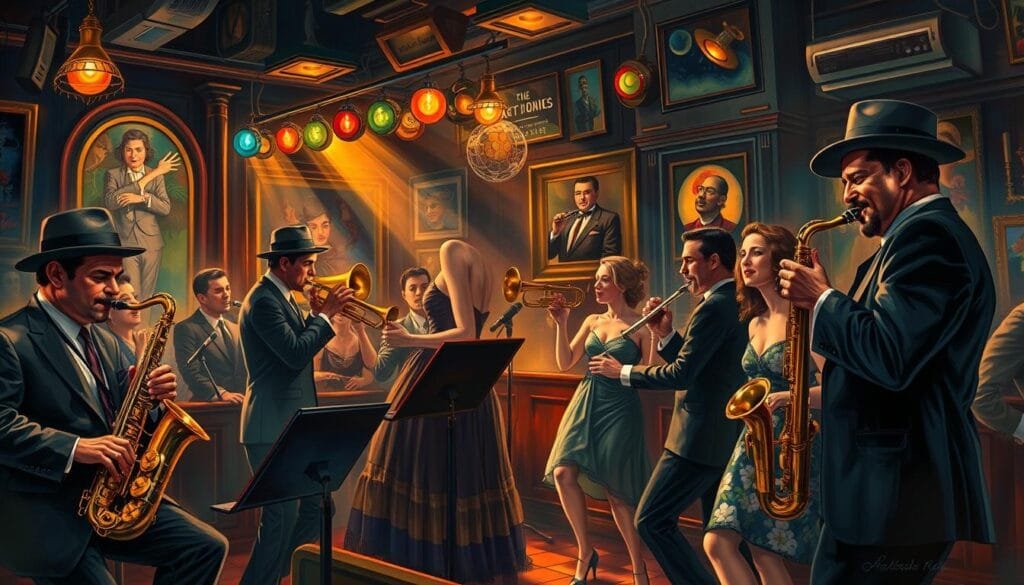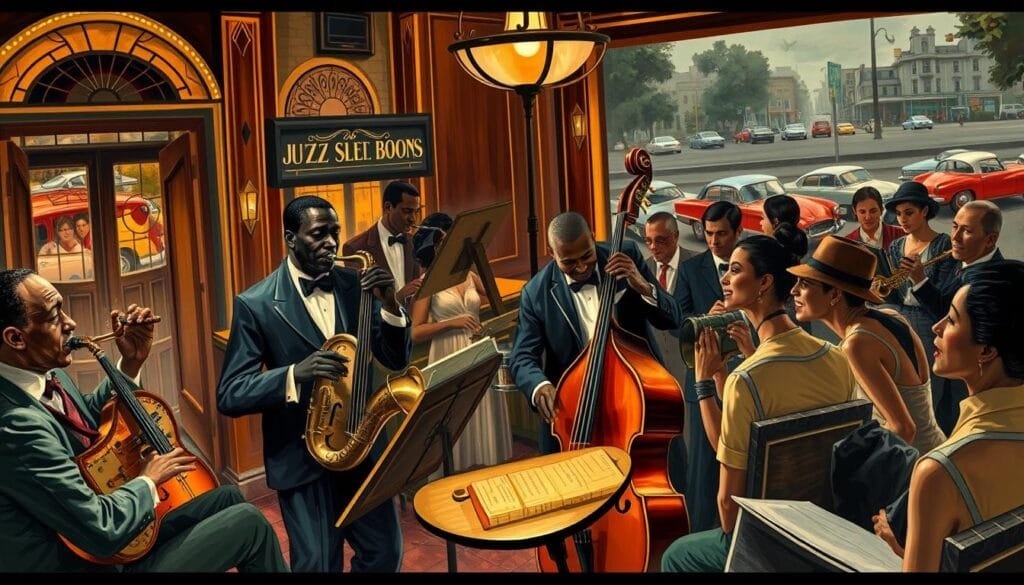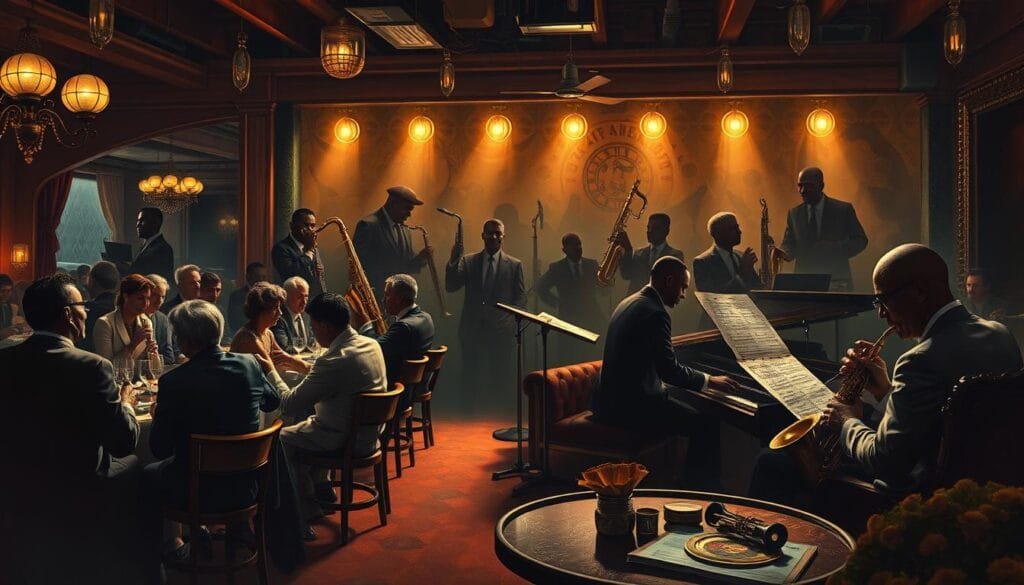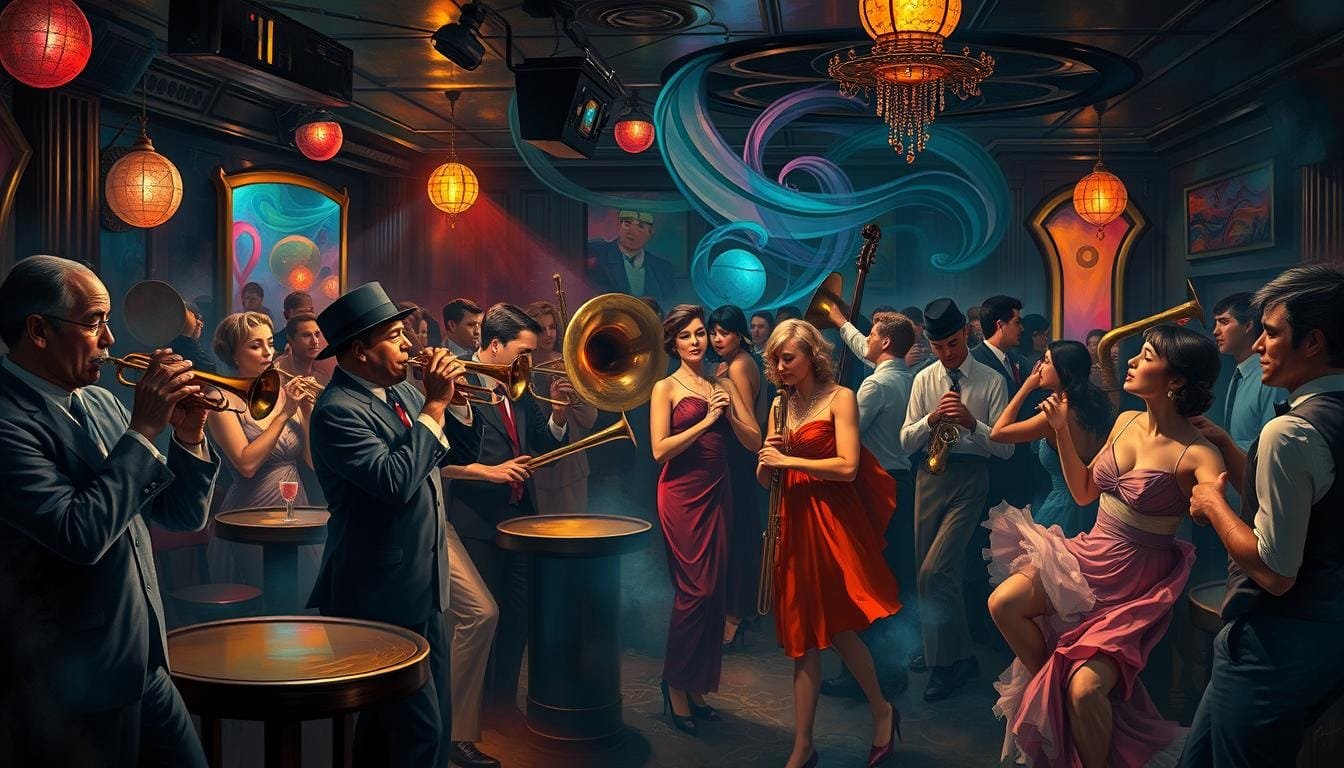Have you ever thought about the impact of jazz on African American culture in the 1920s? This music, central to American culture, changed the social and cultural landscape for Black communities. It marked the beginning of a new era. Dr. Michael Eric Dyson believes jazz was more than music. It was a cultural statement that captured the essence of Black life, helping marginalized voices to be heard.
The impact of jazz goes beyond just music. It fueled the Harlem Renaissance, a time of great cultural growth for African Americans. This period became a milestone, showing the real experiences of African Americans and setting new cultural standards nationwide.
In cities like Seattle and New York, jazz clubs became hubs of artistic freedom. Spots like the Alhambra Cabaret and the Café Society were not just for fun. They stood for resistance, togetherness, and the fight for equality. The jazz of the 1920s shone as a symbol of creativity and resilience, despite societal challenges.
Key Takeaways
- Jazz was more than a music genre; it was a cultural movement reflecting and shaping African American culture.
- The Harlem Renaissance was significantly influenced by the evolution of jazz, promoting black voices and artistic expressions.
- Jazz venues like the Alhambra Cabaret and Café Society were crucial social spaces fostering racial integration.
- Notable jazz musicians broke racial barriers, contributing to political activism and cultural awareness.
- The 1920s jazz influence continues to be recognized as a foundational element of American cultural history.
The Birth and Evolution of Jazz
The Origins of Jazz come from the experiences of African Americans. They mixed work songs, spirituals, and blues to create something new. This music began in New Orleans, famous for its mix of cultures and musical styles. Jazz was more than a style of music. It was a way for people to show their feelings and creativity.
The Roots of Jazz in African American Culture
New Orleans is seen as the home of jazz. It was a place where many cultures came together. Here, a new sound was born, telling the stories of the Black community’s life. Early jazz was shaped by field hollers, slave songs, and the blues. It became a true part of American music history.
Emergence of Jazz as an American Art Form
In the early 20th century, jazz became a key American art form. The music industry began recording this music, like the “Livery Stable Blues” in 1917. Then, stars like Louis Armstrong and Duke Ellington showed the world jazz was not just fun. It was important to America’s culture. This was officially recognized with the Jazz Preservation Act of 1987.
- Music industry segregation initially restricted broader marketing access for African American musicians.
- Up until the late 19th century, the increased affordability of musical instruments facilitated the rise of home-brewed jazz compositions.
- The jazz band set-up fostered a meritocracy, positioning black musicians as equal or sometimes superior to their white counterparts.
Influence of Blues on Jazz
The Blues influence on Jazz is huge. Blues laid the emotional foundation for jazz. Billie Holiday’s “Strange Fruit,” released in 1939, sold over a million records. This song showed jazz could be powerful in social protest. Jazz then led to rhythm and blues and rock n’ roll. This shows how jazz changed music forever.
Now, let’s consider some data to see how jazz changed music and culture.
| Aspect | Jazz Impact | Broader Influence |
|---|---|---|
| Era | 1917-1940s | Post WWII |
| Key Musicians | Louis Armstrong, Duke Ellington | Elvis Presley, Chuck Berry |
| Genres Born | Rhythm and Blues, Bebop | Rock n’ Roll, Pop |
| Social Impact | Meritocracy within bands, Rise of African American protest songs | Integration of black and white musicians, broader acceptance of black culture |
How the Jazz Age Affect Black Culture
The Jazz Age was a key time for Black culture, filled with growth and major achievements. Jazz came from African American experiences. It grew from slave songs, Negro Spirituals, Ragtime, and the Blues. By 1920, it spread across the Mississippi Delta, New Orleans, northern cities, and Europe. The Great Migration moved millions of African Americans to cities, spreading jazz even further.
Jazz as a Platform for African American Expression
Jazz became a way for African Americans to share their voices, battles, and culture. It was the first time Black musicians could express their struggles and hopes through their music. Performing in clubs and theaters, they challenged social norms and pushed for civil rights.
The Role of Jazz in the Harlem Renaissance
In the Harlem Renaissance, jazz was at the heart of an artistic boom. It offered entertainment and a space for deep cultural discussions. The era significantly impacted the arts, creating a lasting influence. Venues like the Cotton Club showcased Black talent to predominantly white audiences, showing the era’s complex racial dynamics. Duke Ellington and Louis Armstrong became jazz legends, highlighting the Harlem Renaissance’s cultural significance.

Jazz and the Great Migration
The Great Migration saw African Americans leave the South for northern cities. This movement brought their music, reshaping places like New York, Chicago, and Seattle. Jazz musicians played a key role in this cultural shift. Earl “Fatha” Hines noted that performers were among the first to fight segregation in the North.
Jazz became popular with white audiences, leading to packed dance halls and clubs run by Black artists. This music scene helped bridge racial gaps. It offered Black Americans a chance for success and moments of integration. Jazz blended hopes and challenges, fostering wider cultural understanding.
For more insights into jazz’s impact on African American culture, check out our full article here.
Socio-Economic Impact of Jazz on Black Communities
Jazz’s growth in the 1920s not only added to America’s culture but also helped Black communities economically. It opened up economic doors and supported Black business owners. The Jackson Street Jazz District in Seattle is a perfect example.

These cultural spots were key in developing black communities. They offered places for shows and artistic sharing. At the same time, they helped grow businesses and services related to jazz. The cultural economy in Black America grew as businesses near jazz spots, like clubs and restaurants, did well.
The Economic impact of Jazz also improved social standing. It created opportunities for many Black musicians to move up the social ladder. With jazz’s popularity, Black entertainers earned more. This opened up new economic chances that were hard to find due to racial issues.
- During the 1920s, jazz’s growth meant better pay for Black entertainers.
- In 1927, 100 million phonograph records sold showed how popular jazz was.
- By the 1920s end, over 12 million U.S. homes had a radio. Jazz became a main entertainment and information source.
The rise of jazz was also tied to the Great Migration. Black Americans moved from the South to Northern cities. This move made Black culture stronger and set jazz as a key part of Black America’s cultural economy.
| Impact Areas | Details |
|---|---|
| Economic Opportunities | Jazz venues spurred Black entrepreneurship and job creation |
| Social Mobility | Increased wages for Black entertainers and upward mobility |
| Community Development | Cultural hubs supporting local businesses and services |
| Migration Influence | Great Migration enhanced Black cultural visibility in urban areas |
Jazz also changed social structures and helped narrow the racial divide. Despite ongoing racism, the cultural economy in Black America was strengthened by jazz. This made jazz a key player in improving Black communities’ socio-economic condition.
The Resilience and Exploitation of Black Jazz Musicians
The history of jazz is deeply tied to the stories of Black musicians. These artists shaped the genre but also faced big challenges. They dealt with financial exploitation, little recognition, and racial barriers. Yet, their journey shows resilience and a quest for better social standing.
Financial Exploitation of Black Jazz Musicians
In the early 20th century, many African American musicians were financially exploited. Their creative work fueled jazz, yet white artists often made more money. These injustices included bad contracts and stolen royalties. Still, these musicians kept creating influential work.
Social Recognition and Upward Mobility
Black musicians worked hard for social recognition. Take Louis Armstrong, his talent led to better social standing. His solo acts in the 1920s changed jazz and improved African American musicians’ status. However, they had to fight hard against racism to succeed.

Integration and Racial Barriers in Jazz
Jazz integration was a big step forward in music and society. The Harlem Renaissance was part of the New Negro Movement. It helped Black musicians get recognized. Benny Goodman’s mixed bands challenged racial limits. It highlighted Black talent and sparked important talks on integration and equality.
| Jazz Development Period | Key Figures | Impact |
|---|---|---|
| 1920s (Harlem Renaissance) | Louis Armstrong | Innovative solo performances |
| 1930s (Swing Era) | Benny Goodman | Integration in bands |
| 1940s (Bebop Era) | Charlie Parker, Dizzy Gillespie, Thelonious Monk | Increased instrumental complexity |
The road to acceptance for Black jazz musicians was long and hard. They faced exploitation and racism. But their perseverance led to significant social change. They paved the way for future Black artists.
Conclusion
The Jazz Age was a key time that changed American culture deeply, especially for Black communities. Jazz started within African American areas in the 1920s. It grew from New Orleans streets to Harlem’s buzzing scenes and more. Its unique rhythms and styles offered new ways for people to express themselves. This influenced movements for civil rights and fairness in society.
Jazz artists played a big role in shaping America’s music and how people express feelings. The Great Migration was important for spreading jazz, as many African Americans moved north. They brought their culture with them, mixing it with new experiences. Even with racism, jazz helped start changes. It made people work together, no matter their race.
The Jazz Age left a lasting mark on today’s music, including pop, R&B, and hip-hop. This period’s influence goes beyond music, affecting American culture as a whole. Looking back at jazz’s history, we see its role in creativity and fighting for change. It continues to motivate and change stories around the world.
FAQ
How did the Jazz Age impact African American culture?
The Jazz Age, a vital period in the 1920s, deeply touched African American culture. It spurred artistic expression and aided the Harlem Renaissance. This era also set new cultural standards in America. Jazz expressed the depth of Black life, leading to broader integration and advances.
What are the origins of jazz music?
Jazz began in New Orleans, mixing influences like African American work songs, spirituals, and blues. This blend led to jazz’s powerful voice of resistance and expression.
How did jazz evolve as an American art form?
Jazz grew by absorbing various musical styles, becoming a cultural and resistance symbol. The Jazz Preservation Act of 1987 acknowledged its American significance.
What role did jazz play during the Harlem Renaissance?
Jazz was key in the Harlem Renaissance, offering a stage for creativity and discussions. It amplified Black voices, fostering identity and unity.
How did the Great Migration influence jazz music?
The Great Migration moved African Americans and their music from the South to the North. This reshaped cities like New York and Chicago, spreading jazz.
What socio-economic impact did jazz have on Black communities?
Jazz opened economic doors for Black communities, encouraging entrepreneurship. Places like Seattle’s Jackson Street Jazz District promoted growth and exchange.
How were Black jazz musicians exploited, and how did they show resilience?
Black jazz musicians often faced exploitation and less recognition than whites. Despite this, icons like Louis Armstrong and Duke Ellington stood up for equality.
How did jazz contribute to social mobility and racial integration?
Jazz pushed social mobility and mixed-race bands, sparking discussions on racial equality. Musicians like Benny Goodman highlighted Black talents, easing jazz’s acceptance worldwide.
What is the legacy of the Jazz Age on modern music and culture?
The Jazz Age’s impact lingers in today’s music and culture. It empowered communities, fueled rights movements, and remains key to American heritage and creativity.
